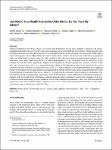I am Robot, Your Health Adviser for Older Adults: Do You Trust My Advice?
| dc.contributor.author | Giorgi, I | |
| dc.contributor.author | Gianni, M | |
| dc.contributor.author | Palomino, M | |
| dc.contributor.author | Masala, G | |
| dc.contributor.author | Minutolo, A | |
| dc.contributor.author | Tirotto, F | |
| dc.contributor.author | Hagen, O | |
| dc.contributor.author | Esposito, M | |
| dc.date.accessioned | 2023-06-08T10:30:10Z | |
| dc.date.available | 2023-06-08T10:30:10Z | |
| dc.date.issued | 2023-06-08 | |
| dc.identifier.issn | 1875-4791 | |
| dc.identifier.issn | 1875-4805 | |
| dc.identifier.uri | https://pearl.plymouth.ac.uk/handle/10026.1/20961 | |
| dc.description.abstract |
Artificial intelligence and robotic solutions are seeing rapid development for use across multiple occupations and sectors, including health and social care. As robots grow more prominent in our work and home environments, whether people would favour them in receiving useful advice becomes a pressing question. In the context of human–robot interaction (HRI), little is known about people’s advice-taking behaviour and trust in the advice of robots. To this aim, we conducted an experimental study with older adults to measure their trust and compliance with robot-based advice in health-related situations. In our experiment, older adults were instructed by a fictional human dispenser to ask a humanoid robot for advice on certain vitamins and over-the-counter supplements supplied by the dispenser. In the first experimented condition, the robot would give only information-type advice, i.e., neutral informative advice on the supplements given by the human. In the second condition, the robot would give recommendation-type advice, i.e., advice in favour of more supplements than those suggested initially by the human. We measured the trust of the participants in the type of robot-based advice, anticipating that they would be more trusting of information-type advice. Moreover, we measured the compliance with the advice, for participants who received robot-based recommendations, and a closer proxy of the actual use of robot health advisers in home environments or facilities in the foreseeable future. Our findings indicated that older adults continued to trust the robot regardless of the type of advice received, highlighting a type of protective role of robot-based recommendations on their trust. We also found that higher trust in the robot resulted in higher compliance with its advice. The results underpinned the likeliness of older adults welcoming a robot at their homes or health facilities. | |
| dc.format.extent | 1-20 | |
| dc.language | en | |
| dc.publisher | Springer | |
| dc.subject | Robot adviser | |
| dc.subject | Robot-based advice | |
| dc.subject | Advice taking | |
| dc.subject | Human-robot interaction | |
| dc.subject | HRI | |
| dc.subject | Trust | |
| dc.subject | Compliance | |
| dc.subject | Senior care | |
| dc.title | I am Robot, Your Health Adviser for Older Adults: Do You Trust My Advice? | |
| dc.type | journal-article | |
| dc.type | Article | |
| dc.type | Early Access | |
| plymouth.author-url | https://www.webofscience.com/api/gateway?GWVersion=2&SrcApp=PARTNER_APP&SrcAuth=LinksAMR&KeyUT=WOS:001003212100001&DestLinkType=FullRecord&DestApp=ALL_WOS&UsrCustomerID=11bb513d99f797142bcfeffcc58ea008 | |
| plymouth.publication-status | Published online | |
| plymouth.journal | International Journal of Social Robotics | |
| dc.identifier.doi | 10.1007/s12369-023-01019-8 | |
| plymouth.organisational-group | |Plymouth | |
| plymouth.organisational-group | |Plymouth|Faculty of Science and Engineering | |
| plymouth.organisational-group | |Plymouth|Faculty of Science and Engineering|School of Engineering, Computing and Mathematics | |
| plymouth.organisational-group | |Plymouth|REF 2021 Researchers by UoA | |
| plymouth.organisational-group | |Plymouth|Users by role | |
| plymouth.organisational-group | |Plymouth|Users by role|Academics | |
| plymouth.organisational-group | |Plymouth|REF 2021 Researchers by UoA|UoA11 Computer Science and Informatics | |
| dcterms.dateAccepted | 2023-05-15 | |
| dc.date.updated | 2023-06-08T10:30:09Z | |
| dc.rights.embargodate | 2023-6-9 | |
| dc.identifier.eissn | 1875-4805 | |
| rioxxterms.versionofrecord | 10.1007/s12369-023-01019-8 |


